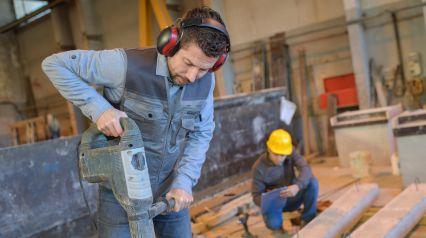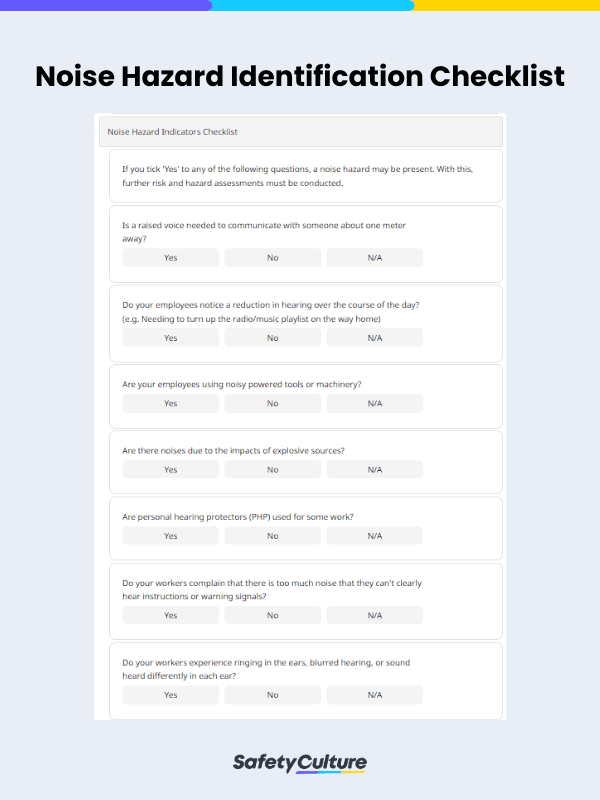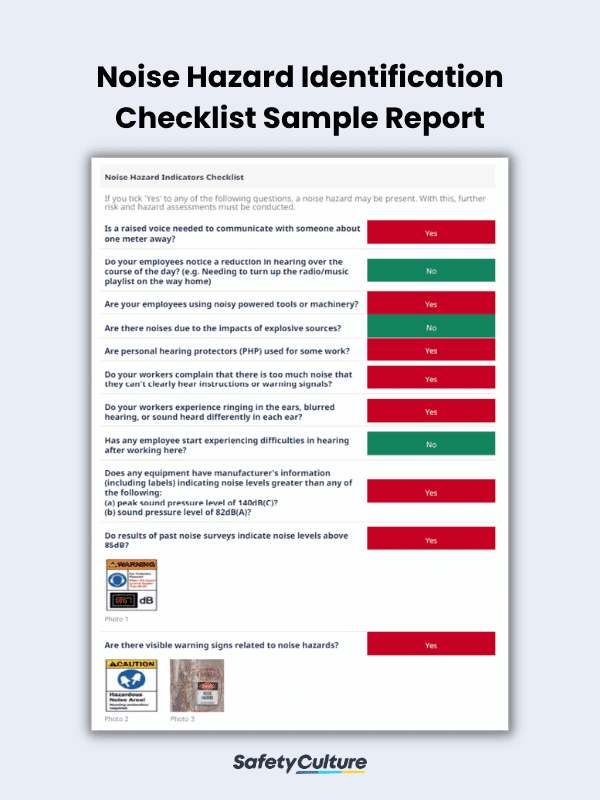What is a Noise Hazard Identification Checklist?
A noise hazard identification checklist is a tool used to assess and identify potential sources of noise hazards in the workplace. It contains a comprehensive list of questions and considerations to help employers and safety professionals identify areas where noise hazards may be present and recommend actions to address them.
Purpose
Noise hazards are defined as any sound that can harm or damage an individual’s hearing ability. In a workplace environment, noise hazards can be created by machines, equipment, tools, and even the work environment itself. According to the Occupational Safety and Health Administration (OSHA), noise levels above 85 decibels (dB) can cause hearing damage. To put that into perspective, a lawnmower produces around 90-95 dB, while a chainsaw can produce around 106-120 dB.
Occupational noise exposure can lead workers to experience temporary or permanent hearing damage, tinnitus, and other related issues. This is why it’s important to have measures in place to help address and minimize this hazard to improve workplace safety.
The primary purpose of a noise hazard identification checklist is to help employers conduct streamlined inspections and audits to identify potential sources of hazards in the workplace. By doing so, employers and safety professionals can develop and implement effective hazard control measures and reduce their potential of harming workers.
A comprehensive checklist can also help identify areas where additional training, resources, or equipment may be needed to reduce noise exposure levels effectively. It can serve as a reference tool for ongoing noise hazard management and ensure that noise exposure levels remain within safe limits.
What to Include in a Noise Hazard Identification Checklist
The checklist typically includes components and questions related to the following:
- Identification of the different areas of the workplace where noise hazards may be present
- Noise levels
- Sources of noise
- Duration and frequency of exposure
- Availability and use of Personal Protective Equipment (PPE)
- Visible warning signs and effective communication systems (e.g. hazard communication policies, safety signs, and safety symbols)
- Use of noise barriers, sound-absorbing materials, and machine enclosures to minimize noise hazards and risks
How to Create One
In creating a noise hazard identification checklist, it’s important to customize it according to the needs of your workplace and workers. To guide you, here are some general steps on how you can create one:
- Identify all potential sources of noise hazards in the workplace. This can include equipment, machinery, and tools that produce high levels of noise, as well as processes that may expose workers to loud or sudden noises.
- Assess the noise levels associated with each hazard. This can be done using noise meters or other tools that measure decibel levels.
- Encourage those who will use the checklist to provide notes, annotations, and media attachments to supplement findings with further documentation.
- Add a Completion page wherein the inspector, assessor, or auditor can place their recommendations and sign off.
- Review and update the checklist regularly to ensure that it’s comprehensive and up-to-date with current regulations and guidelines.
How to Fill Out One
Here’s a sample guide on how you can use and complete a noise hazard identification checklist during inspections or assessments:
- Review the checklist to become familiar with its format and the types of information it requires.
- Look for potential noise hazards in the workplace, such as equipment, machinery, and tools that produce high levels of noise, as well as processes that may expose workers to loud or sudden noises.
- Answer Yes-No-N/A questions to identify potential noise hazards.
- Record the recommended control measures that will be put in place to address noise hazards.
- Determine and note if workers need training and education on the risks associated with exposure to high levels of noise, how to properly use PPE, and other ways to protect themselves from noise hazards.
Examples
Here are some real-world examples of how noise hazard identification checklists can be used in different industries:
- Construction – site preparation, demolition, and excavation activities, which can involve the use of equipment and tools such as cranes, jackhammers, and power tools
- Manufacturing – use of machinery and equipment in manufacturing facilities, such as conveyor belts, presses, and grinders
- Healthcare – identify noise hazards coming from various sources, including alarms, intercom systems, and patient care equipment
FAQs About Noise Hazard Identification Checklists
Conduct a noise assessment or evaluation of your workplace or environment by using sound level meters to identify areas or equipment that may be producing excessive noise. You can also consider the duration and frequency of exposure to these noise sources and the potential impact on workers’ hearing health.
Additionally, you can review available information about the noise levels of specific equipment or machinery that workers use and compare them to recommended exposure limits. This can often be found in product manuals or from the manufacturer. It’s also important to consider the potential for noise to be reflected or amplified by the surrounding environment, such as walls or other structures.
Noise hazard identification checklists are used by employers, safety professionals, and other individuals responsible for ensuring workplace safety. Organizations must designate responsible personnel who can take charge of overseeing or spearheading the use of these checklists and ensure that Standard Operating Procedures (SOPs) in noise hazard identification and assessment are properly implemented.
Noise hazard identification checklists should be completed regularly, especially when new equipment or processes are introduced into the workplace that may create new noise hazards. Employers should also review and update their noise hazard identification checklists as needed to ensure they remain effective and relevant to the nature of tasks being performed in the workplace.
Yes, a noise hazard identification checklist can be customized for a specific workplace to ensure it accurately reflects the potential noise hazards and control measures unique to it. This way, the aspects being checked or inspected are relevant to the type of machinery or equipment being used as well as the environment of the workers.




